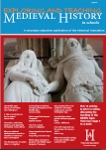Exploring and Teaching Medieval History
 An Historical Association publication free to all teachers
An Historical Association publication free to all teachers
In 2016 fifteen teachers took part in the Historical Associationís Teacher Fellowship course on late medieval history. The aims for the eight-month course were to deepen teachersí knowledge, discuss how we teach this period and produce resources for other teachers to use. Happily we made the ideal start, thanks to the insights provided in the very first session when Professor Anne Curry introduced us to the organisation of the English military campaign of 1415 that led to the battle of Agincourt.
From then on, the word most repeated that weekend was ‘sophisticated’ – as in ‘we had no idea that medieval administration, record-keeping, military planning etc etc etc was so sophisticated’. Our course over the following months continued to be informed by this insight, with ‘sophistication’ supplemented by other key words and phrases we now applied to the people of the Middle Ages – ‘thoughtful’, ‘inventive’, ‘questioning’, ‘highly-organised’, ‘creative’, ‘intelligent’, ‘sense of community’. Teachers’ respect for the people of the later Middle Ages increased significantly. Being a well-mannered Fellowship organiser, I didn’t punch the air in glee. Not in public anyway!
Two years later the HA published Exploring and Teaching Medieval History (ETMH) which was, in a sense, that Teacher Fellowship course writ large, with a much greater range of academic contributions, deeper consideration of teaching issues and a focus on the longer period of c.1000-c.1530. A copy of ETMH was sent free to every secondary school in England and Wales, thanks to funding provided by the Agincourt600 Project which had also funded the Teacher Fellowship. In addition, a longer version of ETMH (140 pp compared with the printed 94pp) was made available open-access on the HA website (see the links below for free access).
ETMH was planned with the aim of helping teachers re-think their approach to teaching the Middle Ages, both by providing articles by historians which reflect recent research and underscore the idea of respect for the sophistication of the period and its men and women. These articles are followed by discussions of a variety of aspects of teaching, including how to create a more representative a picture of the Middle Ages than students often receive – war and plague may be classroom box-office on a wet and windy afternoon but we should be presenting a more representative, respectful and sophisticated picture of the Middle Ages, a period in which much change took place, without glossing over the hardships and problems – a picture much more in keeping with the interpretations of the period created by historians.
You can download ETMH from the HA website HERE …
(HA membership is not needed)And see the contents pages HERE …
As editor of ETMH I do hope teachers continue to enjoy the articles and find them useful and thought-provoking. However this work didn’t stop with ETMH – this section of Thinkinghistory was developed to build on the ideas in ETMH and you can find further articles on teaching about the Middle Ages and a set of classroom resources in the form of textbook chapters HERE …
Finally I would like to thank Agincourt600, led by Professor Anne Curry, for their support and the historians who wrote such a splendid array of articles. Non-medievalists may not appreciate quite how eminent a team of historians has been assembled but take my word for it – this is a deeply distinguished group of authors!
